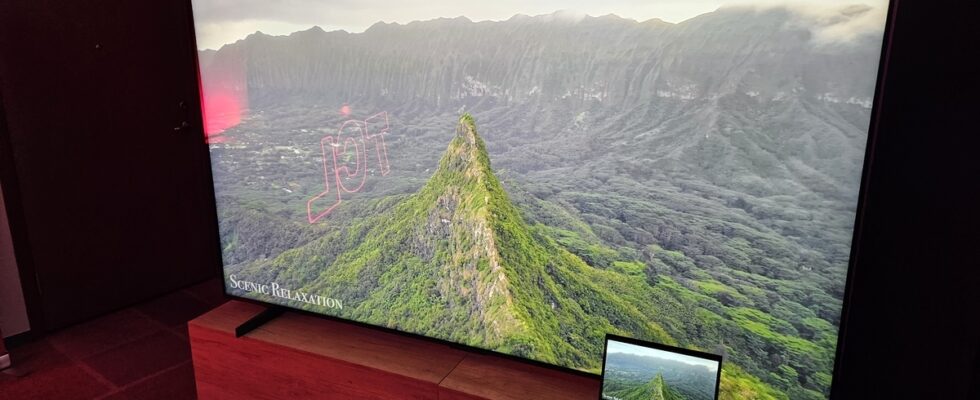TCL 98X955

Fnac.com
€7,999.00Nine

Darty.com
€8,038.00Nine

Rakuten
€8,700.00Nine
How the pricing table works
Turn off your ad blocker to access all of the links above.
TCL 85X955

Boulanger.com
€4,990.00Nine

Rakuten
€4,990.00Nine

Fnac.com
€4,999.00Nine

Darty.com
€5,038.00Nine
How the pricing table works
Turn off your ad blocker to access all of the links above.
98 inches is big, very big, even next to a 1.83 m bearded guy.
We were able to handle these large televisions for a few hours – not enough to do a complete test unfortunately – and took the opportunity to verify TCL’s promises, by looking at the calibration of their panels, as well as their electricity consumption (spoilerpay attention to your EDF bill).
An impressive peak of brightness
Firstly, on the brightness side, TCL went to get this figure of 5000 nits (cd/m²) far up its magician’s sleeves. Announcements from tech product manufacturers are sometimes sprinkled with gimmicky powder to delight the eyes and ears, but the reality is sometimes a little less rosy. According to TCL, it is possible to approach this value only under certain conditions, when a boost mode is activated and if the image displayed on the screen allows it. Just go to the official 98X955 page to see a first element that brings us closer to reality.
The TCL site mentions several brightness peaks.
5000 cd/m² or 2400 cd/m²? It goes from single to double, but the second option seemed more plausible. During our tests, we were indeed able to reach 2400 cd/m² in Standard image mode and a bit less in Film mode, 2310 cd/m² to be precise. A value certainly far from 5000 cd/m², but which remains no less impressive: it is 1000 cd/m² more than the current high-end Oleds. The result is better rendering accuracy when your series or film displays high dynamic range (HDR) scenes, from dark areas to the brightest. On the 85-inch X955, we noted a lower brightness peak, but it still peaked at 2043 cd/m², a great feat. On the EOTF curve below, we see that the TV does not smooth the curve and follows it a little too closely: concretely, from clipping (loss of detail in very bright areas) appears on the screen in some scenes.
Peak brightness in Movie mode.
VA panel requires, the contrasts are obviously not as important as on Oled models, but with a ratio of 4000:1, we perceive really deep blacks. The slab is of course subject to blooming (the halo effects around luminous objects on a dark background), but the phenomenon is well controlled thanks to the large quantity of LED zones present at the back of the TV (a little more than 5000 in total) and does not stain like on some entry-level models. The viewing angles are not optimal by the way: it is better to stay in front of the television with this type of panel.
The thousands of mini-LEDs of the TCL 85X955 without the other layers of the screen.
Precise calibration
In terms of calibration, we had to fight with capricious firmware and above all deactivate all dynamic contrast settings, local dimming and other adaptive brightness to achieve stable and correct results. In Film mode, the results are excellent in HDR with a delta E of 2.4 for the 98-inch model and 1.9 for the 85-inch.
The delta E in HDR is 2.4.
In SDR, we measured a delta E of around 1.5, but be careful, the color temperature was frankly cold, around 8100 K, even if we had chosen a warm white balance in the settings. With Game mode, which often distorts the image, everything remained on track since the delta E stagnated around 2. Who knows why, the average temperature is even better than in Film mode, since it is established in average at 7700 K. The gamma is not perfect, with grays sometimes moving away from the reference curve, but the average of 2.3 remains very close to the expected value.
The delta E of 1.5 in SDR is excellent.
The gamma curve is not perfect, but remains generally faithful.
Quid consumption?
Obviously, we can ask ourselves the question of the consumption of such a 98-inch television, equivalent to almost four 50-inch TVs. On our usual target at 150 cd/m², we noted a consumption of 93 W, a very correct value compared to a TCL 65C935 (65 inches) which burns 81 W under the same conditions. The relative consumption is therefore established at 35 W/m², which is ultimately very low. But we had to lower the brightness to 12 out of 100, and more “classic” use could have a completely different result: we noted 270 W on YouTube with brightness at 50%. At maximum, still in video playback, consumption rises to 375 W, but there is little chance that you will push the settings that far in real conditions.
We will offer you a complete test if TCL is able to send such large models to the editorial staff, but we can already get an idea of what these giants offer. Provided you pay the price of course, the 85X955 being sold for €4000 and the 98X955… €8000.
